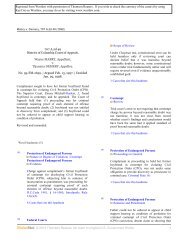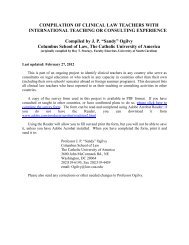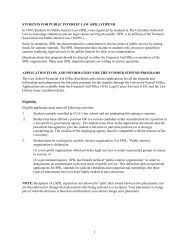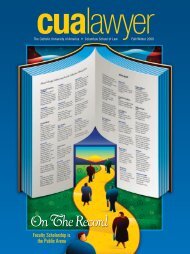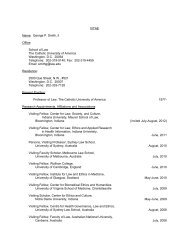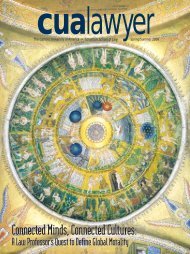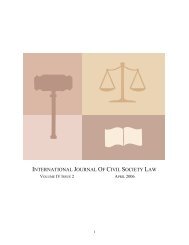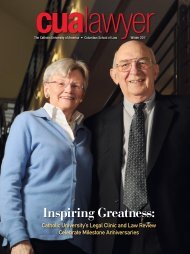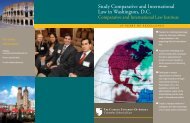Shewarega v. Yegzaw - Law Clinics
Shewarega v. Yegzaw - Law Clinics
Shewarega v. Yegzaw - Law Clinics
Create successful ePaper yourself
Turn your PDF publications into a flip-book with our unique Google optimized e-Paper software.
<strong>Shewarega</strong> v. <strong>Yegzaw</strong>, 947 A.2d 47 (2008)3 D.C.Code § 16–1001(5) was amended in respects not pertinent to our construction of the statute in this case by D.C. <strong>Law</strong> 16–306,§ 206(a), 53 D.C.Reg. 8610 (effective Apr. 24, 2007).4 D.C.Code § 16–1005(f) provides that violation of a civil protective order is punishable as contempt.5 See, e.g., Baker v. United States, 891 A.2d 208, 212 (D.C.2006) ( “[E]ven assuming for the sake of argument that the trial court’sno-contact order was invalid, Baker’s conviction for contempt must be upheld for his failure to comply with that order.”) (citationsomitted); In re Marshall, 445 A.2d 5, 7 (D.C.1982) (“[A]ppellant had an obligation either to comply with the court order ... or toseek to have the order vacated.”); In re Evans, 411 A.2d 984, 993 n. 10 (D.C.1980) (“As a general rule, ‘[v]iolations of an order arepunishable as criminal contempt even though the order is set aside on appeal.’ ”) (quoting United States v. United Mine Workers,330 U.S. 258, 294, 67 S.Ct. 677, 91 L.Ed. 884 (1947)).6 Kammerman v. Kammerman, 543 A.2d 794, 799 (D.C.1988).7 See In re Banks, 306 A.2d 270, 273 (D.C.1973) (stating that a void order “could be disobeyed with impunity”).8 Kammerman, 543 A.2d at 799 (internal citations omitted); see also Marshall, 445 A.2d at 7 (“The court had jurisdiction of theparty and of the subject-matter. Hence, however defective or erroneous the proceedings, the judgment was not void, and could, atmost, be voidable.”) (quoting Hunter v. United States, 48 App. D.C. 19, 23 (1918)).9 D.C.Code § 16–1001(5) (1994 Supp.) (emphasis added).10 McKnight v. Scott, 665 A.2d 973, 975 (D.C.1995).11 Sandoval v. Mendez, 521 A.2d 1168, 1171 (D.C.1987).12 See D.C. <strong>Law</strong> 10–237, § 2(a), 42 D.C.Reg. 36, 1636 (effective March 21, 1995). According to a Judiciary Committee Report,witnesses had urged the Council to broaden the definition of an intrafamily offense to cover, inter alia, “non-intimate acquaintancesituations, such as housemates,” or “any relationship where there is a very close association, contact, or familiarity.” COUNCILOF THE DISTRICT OF COLUMBIA COMM. ON THE JUDICIARY, Report on Bill No. 10–477, the “Domestic Violence inDating Relationships Act of 1994” (Oct. 12, 1994), at pp. 3, 4.13 See Ba v. United States, 809 A.2d 1178, 1182 n. 6, 1183 (D.C.2002); Mabry v. Demery, 707 A.2d 49, 51 (D.C.1998). Therequirement of willfulness imports knowledge of the court’s order and an intent to do what the order proscribes. See Jones v.Harkness, 709 A.2d 722, 723–24 (D.C.1998).14 See Jones, 709 A.2d at 723; Vereen v. Clayborne, 623 A.2d 1190, 1192 (D.C.1993).15 See Ba, 809 A.2d at 1182–83.16 The trial court did not cite Ms. Taffese’s testimony that appellant “was going to hit” or “came forward to hit” Ms. <strong>Yegzaw</strong>, nor didthe court find that appellant had committed an assault. Because Ms. Taffese did not further describe what she saw appellant do, orotherwise explain her conclusion that appellant was about to hit Ms. <strong>Yegzaw</strong>, we do not think her testimony would support afinding beyond a reasonable doubt that appellant committed either attempted-battery assault or intent-to-frighten assault. SeeRobinson v. United States, 506 A.2d 572, 574–75 (D.C.1986) (contrasting elements of each type of assault); see also Joiner–Die v.United States, 899 A.2d 762, 765 (D.C.2006) (enumerating elements of intent-to-frighten assault).17 Those statutes criminalize only to threats to do bodily harm, see D.C.Code § 22–407 (2001), or threats to kidnap any person or toinjure the person of another or physically damage the property of another, see D.C.Code § 22–1810 (2001).18 D.C.Code § 22–404(e) (2001 & Supp.2007). A violation of the anti-stalking statute can be made out in four different ways, one ofwhich is by proving that the accused on more than one occasion engaged in conduct with the intent to cause emotional distress tothe complainant by willfully, maliciously, and repeatedly harassing the complainant. See D.C.Code § 22–404(b) (2001 &Supp.2007); see also United States v. Smith, 685 A.2d 380, 383 (D.C.1996); Richardson v. Easterling, 878 A.2d 1212, 1217(D.C.2005).19 D.C.Code § 22–404(b).© 2013 Thomson Reuters. No claim to original U.S. Government Works. 6



